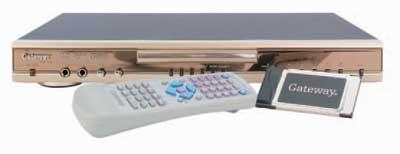Media Receivers

Media receivers bridge the gap between computer and home theater by letting you store your audio and video files in one room while you select and play them on an entertainment system in another room. The first digital media receivers were limited to streaming music stored on a PC over a wired network to your stereo. But hybrid products soon followed - like the Philips FW-i1000 Internet radio minisystem (reviewed in December 2001), which combined a CD player, speakers, and a cassette deck for recording AM/FM or Internet radio. The first of the Philips Streamium line, the FW-i1000 had an RJ-45 Ethernet port so it could deliver not only streaming MP3-based radio from the Net but also MP3 tracks from any computer on your home network. Gateway ADC-320 DVD player/media receiver
Things got more interesting when Hewlett-Packard released its Digital Media Receivers (reviewed in April 2003). Both models received music and digital photographs and could stream them at the same time. By the end of 2003, more companies were offering both dedicated media receivers - many of which received video, too - and models that doubled as DVD players or video hard-disk recorders. As Wi-Fi data speeds have increased from the 802.11b standard, which worked fine for music and images, to the faster, video-friendlier 802.11g standard, newer media receivers have upped their specifications. But an "old-fashioned" wired Ethernet network is still faster than "g" and isn't prone to interference from other wireless devices and networks.
Here are a few things to keep in mind when considering media receivers. First, you need a home network to use any of the products listed here. Second, you can have a number of receivers working off one computer and more than one computer serving up content to a media receiver. So, you could have one receiver in your family room and a second one in the bedroom. Third, pay attention to which receivers work with wired and which with wireless installations. And, fourth, you don't need a degree in computer science to set up a media receiver, but the more you know about your home network, the easier it will be.




























































